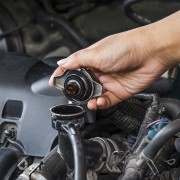If your car's heat gauge is in red, something's wrong under the hood. After pulling over, here's what you should do.
If you’re sitting in traffic, moving slowly or not at all, and you notice the temperature gauge needle on the car is the only thing on the road moving quickly, you might have a problem on your hands. If the needle is moving slowly but surely into the red zone, an engine meltdown is the worst case scenario. But if you take care of the problem soon, you might be able to avoid that.
Get your car to a service garage
With a car overheating, the first thing you want to do is get it into a car repair shop to let a mechanic look at the problem and diagnose the issue. If you are close to your mechanic and have some time on your hands, get it in right away to avoid a major problem.
A couple of factors could be at play with a car overheating. It could be the symptom of a major problem, or it could indicate something less serious. Only your mechanic will be able to tell for sure.
1. Blast the heat
If you can’t get to a local garage right away, turning on the cabin heater to maximum may alleviate the problem, if only temporarily. Blasting the heat on high is way to vent the hot air accumulating in the engine area. The engine temperature may even drop to normal as a result. Depending on the time of year, you might have to open all the windows to avoid the sauna.
2. Have the uptake hose checked
One issue you will definitely want to have your mechanic check on is the uptake hose, which circulates antifreeze and coolant throughout the engine. If the uptake hose has a problem, it will affect the amount of coolant in circulation. The hose could have become ill-fitting over time, or it could have become blocked; a completely blocked hose is a less likely occurrence than a dislocated or loose one. A quick adjustment or a new uptake hose should have you on your way soon.
3. Get your fluids checked
If your car is older or has some wear and tear on it, it is a good idea to make sure you add extra coolant on a regular basis. One way around this problem is to have your mechanic check the fluids, including the coolant, at every spring and fall tire change. However, if you know you have enough coolant and yet you still have a car overheating on its own, it may be time for a new engine or transmission. That can be an expensive job.
The best advice for saving money in this situation? Avoid a do-it-yourself diagnosis and get to a professional right away.









